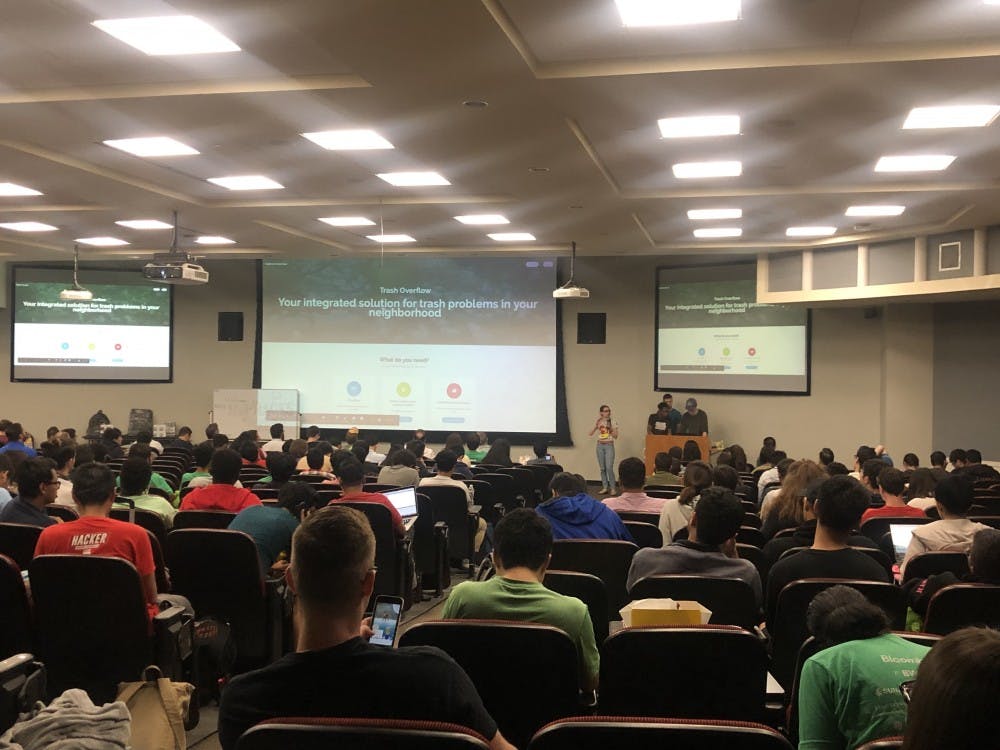HopHacks, a biannual hackathon hosted at Hopkins, held their first 36 hour marathon session of the 2019-2020 academic year, which started last Friday and concluded Sunday.
HopHacks Public Relations Head Rachel Rosset, a junior, said that HopHacks wanted to host a hackathon which focused on designing solutions that would bring positive change to the city of Baltimore and all around the world.
“The goal for HopHacks is to get people together to create something fun and interesting,” Rosset said.
For this semester, HopHacks partnered with Microsoft Machine Reading Comprehension (MARCO) to introduce a new natural language processing track. Language processing involves creating programs that enable computers to analyze and understand human language.
Junior Andrew Zhang, who serves as HopHacks director, explained that students worked in teams of up to four people to create a new project from scratch. He noted that teams were given a chance to present their projects to the judges and win prizes up to $1024. There were also smaller prizes that individual sponsors of the event, such as J.P. Morgan Chase & Co. and Bloomberg, could hand out.
Participants were judged on their polish, usefulness, creativity and technical skills.
“We have four criteria that they are judged on. Sponsors, if they have their own branded prizes, themselves determine the sort of criteria that they want to have,” Zhang said.
During the awards ceremony, which took place on the last day of the hackathon, the judges announced that the group NoteShift was the first place winner of the overall HopHacks competition. NoteShift was comprised of four freshman computer science majors from Hopkins. These students are Ricky Cheng, Xiangyu Shen, Lawrence Mao and Tyler Shin.
“We originally came up with the idea in our brainstorming because a lot of us played musical instruments when we were children,” Shin said.
Shin mentioned that when students are in orchestra and band, they are often given music to transpose. However, many may spend the entire length of rehearsal transposing while everyone else is able to play. The team wanted to design a software that would allow people to transpose music more easily.
In addition to winning the first place prize, NoteShift also received other awards. Shen said that one of those other prizes was $1000 from FastForwardU, an organization at Hopkins that provides resources and training to student entrepreneurs to create successful startups. Cheng added that if they were to continue their project, they would consider creating a mobile app.
Shen added that this was the first hackathon for the entire team, and that he was glad to see that they were able to learn a significant amount of new skills in just a 36 hour period, many of which he felt he could apply later in his computing career.
Junior Ayush Dalmia added that he enjoyed coming to HopHacks and had attended the hackathon the past two years.
“The reason that we want to be a part of HopHacks is because it is a great time for us to do projects that you usually don’t do in school,” Dalmia said.
Dalmia said that this event was a great way to meet people from different schools as well as people who were in the industry. He remarked that having representatives from the companies sponsoring the event was good because participants could approach them with questions or difficulties, or even to inquire about future opportunities.
Junior Stewy Slocum said that he had no idea what software his team would be working to develop before he got to HopHacks, and added that the process of designing his project helped him learn new technical skills.
“One big takeaway is being reminded about how fun it is to make things and not let school become everything,” Slocum said.
Junior Harshil Desai, who was on the same team as Slocum, added that a lack of familiarity with the software tools was the biggest obstacle that their group had to overcome. Desai said that his team encountered numerous bugs, but were able to push through the difficulties.
Given the various levels of experience among the participants, Zhang said that HopHacks focused on two different audiences. The first audience included people who were just beginners and who had likely not been to a hackathon before. The second audience was made up of those who were more experienced, and consequently more likely to be competitive.
“The most important thing for me is that participants are able to learn something new in programming or they’re able to network with companies and land an internship,” Zhang said.
Zhang added that there was no specific coding requirement or level of understanding that people needed to participate in HopHacks. The organizers accepted most people who were able to attend, and they looked out for people who showed enthusiasm in their applications.
“Once we actually get to the weekend, it is so much fun with all the hackers and sponsors as well as seeing people excited to be there,” Rosset said.
For the next HopHacks, Rosset would like to see more people from outside the Baltimore area, as many visiting students were from Towson University, the University of Maryland and the Washington D.C. area. The event was open to all undergraduate and graduate students from any university.
Zhang said that, in the end, the best aspect of his experience was watching how the event played out.
“The most rewarding part is seeing the event around you and knowing that your team is so strong that they are able to go off and make sure that HopHacks runs smoothly when you are not there,” Zhang said.





